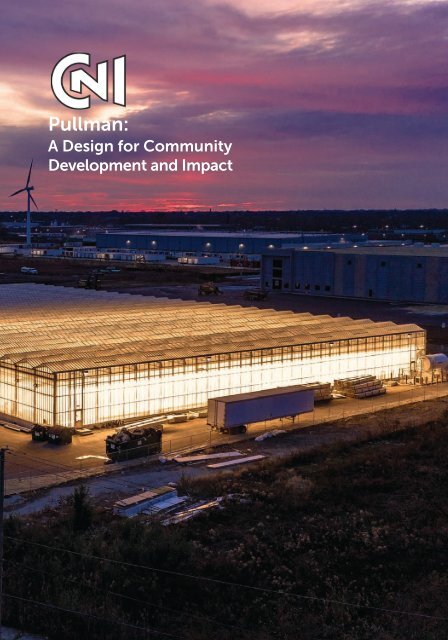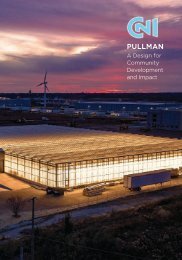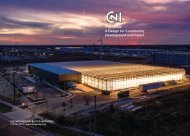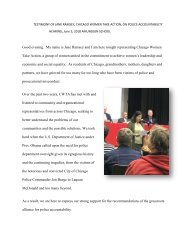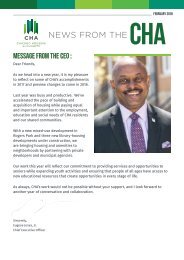CNI Brag Book 2020
You also want an ePaper? Increase the reach of your titles
YUMPU automatically turns print PDFs into web optimized ePapers that Google loves.
Pullman:<br />
A Design for Community<br />
Development and Impact
PULLMAN,<br />
the historic community built in the 1880s by Pullman’s<br />
Palace Car Company, is widely recognized as one of the<br />
nation’s first planned industrial communities. And<br />
because of its Romanesque architecture, also one of its<br />
most beautiful. Now visitors to the neighborhood’s house<br />
tours and the designated Pullman Monument marvel at<br />
the community’s vitality, but this wasn’t always the case.<br />
Rather than spinning another tale of an industrial town<br />
ravaged by neglect and abandonment, Pullman presents<br />
a remarkable story of resilience and recovery.<br />
Pullman was a thriving community throughout much of<br />
the 20 th Century fueled by the rail car and steel<br />
industries. The exodus of industry from the Pullman yard<br />
shutdown in the 1960s through the closing of Ryerson<br />
Steel in 2006 left the community with a loss of jobs and<br />
population and a growing abundance of vacant land,<br />
abandoned historic buildings and soaring unemployment<br />
and crime rates.<br />
While the pundits and the public wrote off Pullman as<br />
just another victim of a changing global economy, there<br />
existed strong local forces that saw potential in the<br />
attributes that others neglected – an unparalleled<br />
location where the nation’s rail, roads and waterways
connect; vast tracts of contiguous, available land; 98% of<br />
its original housing stock which, despite being distressed,<br />
was well-designed and well-built; and a strong grassroots<br />
movement that forged support with local<br />
institutions and elected leaders and were committed<br />
and passionate about revitalizing Pullman.<br />
What was needed to transform hope and dreams into a<br />
strategy and success was a community development<br />
partner. Such a partner was founded in 2008 when a<br />
local bank saw the potential of which others spoke and<br />
created an affiliated nonprofit community development<br />
organization – one that eventually became Chicago<br />
Neighborhood Initiatives (<strong>CNI</strong>).<br />
From the 10 th floor window of the building it occupied,<br />
the fledgling community development organization<br />
could see first-hand the acres of vacant land and<br />
buildings that exemplified the challenge. The defining<br />
question was: “where to begin – by promoting the sale<br />
of the 180-acre site adjacent, or addressing the latest<br />
addition of abandoned homes caused by the recession in<br />
2008, or salvaging the crumbling infrastructure of the old<br />
Pullman Factory?”<br />
<strong>CNI</strong> began its work in Pullman by listening – convening<br />
an extensive community planning process, involving a<br />
myriad of grass-roots block clubs and organizations,<br />
facilitating 80 community meetings and a host of<br />
planning workshops. From this process evolved these<br />
key themes: job creation and retail access; affordable<br />
housing; and recreation and tourism.<br />
While this list of priorities could resonate in many of<br />
Chicago’s or the nation’s under-invested communities,<br />
the next question for <strong>CNI</strong> was how to begin to tackle the<br />
varied objectives? The strategy soon became apparent<br />
during the planning process, and <strong>CNI</strong> took the lead on<br />
the integrated and intersecting need for housing renewal,<br />
increasing employment opportunities and recreational<br />
amenities.
OUR IMPACT<br />
The impact of <strong>CNI</strong>’s efforts can be measured by<br />
looking at what has been produced in terms of<br />
generating investments, creating new developments<br />
and other opportunities that have improved the<br />
quality of life.<br />
<strong>CNI</strong>’s commitment and resources have<br />
turned $132 million of its own coordinated<br />
investment, including over $125 million from U.S.<br />
Bank, into more than $350 million of<br />
additional public and private investments that have<br />
created 1,500 new jobs.<br />
However, there is more to Pullman’s story than job<br />
creation. It has also:<br />
And <strong>CNI</strong>’s commitment and achievements in<br />
the Pullman community were recognized<br />
when it was presented with several prestigious<br />
awards:<br />
| The John Baird Award for Stewardship in<br />
Historic Preservation in 2015 for the restoration<br />
of Pullman’s historic rowhomes.<br />
| The Chicago Community Trust Award for<br />
Outstanding Community Strategy in 2015<br />
| The Burnham Award for Excellence in Planning<br />
from the Metropolitan Planning Council in 2016<br />
| The Neighborhood Housing Services of Chicago’s<br />
Gale Cincotta Community Impact Award in 2019<br />
| The Chicago Innovation Neighborhood Award in 2019<br />
Pullman
+<br />
CREATED<br />
200+ new units of single-, and multi-family<br />
affordable housing<br />
over 1.5 million square-feet of commercial,<br />
industrial and recreational space<br />
INCREASED<br />
number of jobs in the community by<br />
43% between 2010 and 2015<br />
l<br />
number of six-figure households by 58%<br />
number of college graduates by<br />
nearly 10% between 2006 and 2015<br />
property values 136%; Pullman<br />
experienced the second highest level of home<br />
appreciation among all Chicago neighborhoods<br />
average annual rate of new construction<br />
is 20x higher than it was prior to <strong>CNI</strong>’s work<br />
l<br />
DECREASED<br />
violent crime 52% from 2005 to 2015<br />
(Chicago Tribune)<br />
violent crime 34% from 2015 to 2017<br />
(MPC); the area within most of <strong>CNI</strong>’s investment<br />
has not experienced a single homicide since 2014
Credit:<br />
Credit:
Darris Lee Harris<br />
JOB<br />
CREATION &<br />
RETAIL<br />
ACCESS<br />
Following the significant exodus of resident and worker<br />
population from the steel industry closings, <strong>CNI</strong><br />
understood that creating new jobs was the only option<br />
to bring people back to Pullman. So <strong>CNI</strong> turned its<br />
attention to attracting new businesses to generate new<br />
jobs. Using the resources on hand, and through the<br />
extraordinary united efforts of community organizations,<br />
government agencies and local elected officials, <strong>CNI</strong> and<br />
the City of Chicago secured the first national retail-based<br />
shopping center on the city’s South East Side.<br />
In 2012, with an initial $5 million grant from the State of<br />
Illinois for infrastructure work on the former site of Ryerson<br />
Steel, <strong>CNI</strong> broke ground for Pullman Park, a $125 million<br />
mixed-use site at 111 th Street and I-94 anchored by a 150,000<br />
square-foot Walmart Supercenter. As a result of a<br />
Community Benefits Agreement, employees earned higher<br />
wages as compared with other Walmart workers nationwide.<br />
When the Walmart opened in 2014, it was the first and<br />
only store in the area to provide access to quality foods.<br />
Soon it was accompanied by a Ross Dress for Less,<br />
Planet Fitness and an Advocate urgent care clinic. Having<br />
secured additional public transportation routes to better<br />
serve the area, the bustling Pullman Park shopping center<br />
today provides the community not only with goods and<br />
services, but with nearly 700 jobs.<br />
Darris Lee Harris<br />
Three years later, <strong>CNI</strong> developed another retail center –<br />
the 111 th Street Gateway, at the entry to the Pullman
Credit:<br />
Credit:
National Monument site, bringing a Potbelly’s Sandwich<br />
Shop with a drive-thru and a minority-owned Star Dry<br />
Cleaners. And in 2019, the first Food Hall on the city’s Far South<br />
Side opened within the retail center. Today, the One Eleven<br />
Food Hall features three locally owned restaurants, thanks in<br />
part to a $1 million grant from JPMorgan Chase that helped<br />
<strong>CNI</strong>’s Micro Finance Group (<strong>CNI</strong>MFG) make microloans to<br />
entrepreneurs in under-resourced communities.<br />
“All the new retail, housing and cultural amenities signal<br />
Pullman is once again becoming a major destination for<br />
families, businesses and visitors,” said Senator Richard Durbin.<br />
Darris Lee Harris<br />
While focusing on attracting retailers to Pullman Park,<br />
which fronts the expressway and offers unparalleled<br />
visibility along the eastern most portion of the former<br />
Ryerson site, <strong>CNI</strong> had equally ambitious plans for the<br />
west – attracting new businesses for which the rail, road<br />
and water connections would be important assets.<br />
The hard work and strategy paid off. The first company to<br />
locate just west of Pullman Park was Method Home<br />
Products in 2014, one of the world’s leading makers of<br />
environmentally friendly cleaning supplies. It was here<br />
that the company built its first U.S. based plant, a $30<br />
million, 150,000 square-foot manufacturing and<br />
distribution center at 720 East 111 th Street, in a building<br />
that gets almost half of its power from renewable energy<br />
created by a giant wind turbine and solar panels.<br />
“We reviewed more than 100 sites from across the country<br />
but Pullman’s access to transportation and a skilled<br />
workforce were the leading factors in our decision to move<br />
there,” said Method Products Chairman Jonathon Bond.<br />
Gotham Greens<br />
Joining them was another newcomer to Chicago,<br />
Gotham Greens, a pioneer in indoor greenhouse agriculture<br />
and a leading fresh produce and food company which<br />
built the world’s largest commercial rooftop greenhouse<br />
atop the Method plant in 2015. And in the Fall of 2019,<br />
Gotham Greens doubled-down on Pullman and opened<br />
a new 100,000 square-foot, state-of-the-art greenhouse.<br />
The expansion enables Gotham Greens to deliver a year-
Credit:
ound supply of fresh produce to consumers to keep up with<br />
the increasing demand from retail, restaurant and foodservice<br />
customers from across the Midwest. The new greenhouse,<br />
the largest-ever built in Chicago, more than doubles the<br />
company’s local production to 11 million heads of lettuce<br />
annually and doubled its total workforce to more than 100<br />
full-time employees at the two local greenhouses.<br />
“Agriculture is a vital component of our state’s economy,<br />
and I’m pleased to see opportunities for urban<br />
agriculture- like this greenhouse expansion in Pullman,”<br />
said Governor J.B. Pritzker.<br />
Darris Lee Harris<br />
Additional excitement is taking place near the new<br />
Gotham greenhouse where the largest speculative<br />
building is being constructed in the Lake Calumet region<br />
as part of Pullman Crossings, the new 62-acre industrial<br />
park taking shape in Pullman developed by Ryan<br />
Companies and <strong>CNI</strong>. An investment by Allstate in the new<br />
400,000 square-foot warehouse, being built on vacant<br />
land once part of the former Ryerson Steel site, made it<br />
the first Opportunity Zone investment in the area. It is<br />
expected to be completed in <strong>2020</strong>.<br />
Much of the momentum for these projects was sparked in<br />
2018 when Whole Foods opened its new Midwest<br />
Distribution Center. The 150,000 square-foot distribution<br />
center occupying 17 acres of once-vacant land, allows<br />
Whole Foods to join two major suppliers, Method and<br />
Gotham Greens in the Pullman neighborhood. It serves<br />
more than 70 Whole Foods’ locations across the Midwest<br />
and parts of Canada and its 90 employees earn an average<br />
of $42,000 a year. To attract Whole Foods to its new<br />
location and ensure the site was competitive, <strong>CNI</strong> helped<br />
secure $8.4 million in TIF assistance from the City of<br />
Chicago to pay for site preparation costs, including<br />
grading, demolition, and utility installation. The new<br />
Pullman location provides a building double the size of its<br />
former facility in Indiana.<br />
These new manufacturing and distribution entities created<br />
another 400 jobs, making Pullman one of the fastest- and<br />
biggest-growing employment sites in all of Chicago.
AFFORDABLE<br />
HOUSING<br />
While the southern part of the community with its historic<br />
church and parks had long seen stable ownership and a<br />
thriving community life, the northern half of Pullman,<br />
closer to the original Pullman Factory complex was a<br />
different story with failing rental housing amid a sea of<br />
abandoned buildings.<br />
<strong>CNI</strong> began by investing $5 million in the preservation and<br />
renovation of dozens of Pullman’s historic rowhouses for<br />
sale or rent, through its partnership in the Micro Market<br />
Recovery Program with the Neighborhood Housing<br />
Services of Chicago and the City of Chicago. This<br />
neighborhood stabilization initiative provided resources<br />
to renovate and purchase homes in Pullman, in addition<br />
to helping existing homeowners prevent foreclosure.<br />
<strong>CNI</strong> worked to bring Mercy Housing to the community to<br />
take over the Pullman Wheelworks – a mammoth 200<br />
apartment rental complex that had fallen into severe<br />
disrepair and disrepute. <strong>CNI</strong>’s efforts generated a $15<br />
million investment by Mercy Housing that not only vastly<br />
improved the structure but also stabilized the immediate<br />
area, encouraging additional investment like Butler<br />
College Prep, a Noble Charter School, and further<br />
renewal in the community.<br />
Another additional investment came in the form of a new<br />
housing opportunity, one that is making Pullam the<br />
choice for young creative minds – Artspace Lofts, an<br />
innovative work/live space featuring 38 rental apartments<br />
and community space for art fairs and exhibits. <strong>CNI</strong><br />
helped finance the project, securing a mix of grants,<br />
Historic Tax Credits and Low-Income Housing Tax<br />
Credits. Once construction of the new Artspace Lofts is<br />
completed in early <strong>2020</strong>, and its two adjacent historic<br />
buildings are restored, it will be Pullman’s first new<br />
residential construction in approximately 50 years.
RECREATION<br />
& TOURISM<br />
A 20 year-long dream comes to fruition. After being<br />
urged by national and local leaders, preservation groups,<br />
members of the community and other key stakeholders,<br />
President Obama designated a portion of the Pullman<br />
Historic District as part of the National Park System in 2015.<br />
This included the historic clock tower and administration<br />
building at 111 th Street and Cottage Grove where <strong>CNI</strong> and<br />
the National Park Services (NPS) have launched a $35<br />
million renovation project. Once construction is completed,<br />
the clock tower will be transformed into the new Visitor<br />
Center for the Pullman National Monument site, which is<br />
expected to attract more than 300,000 visitors annually.<br />
“The new Center will introduce visitors to Pullman’s rich<br />
history and will encourage people to explore the community<br />
and visit other local historic sites, including the National<br />
A. Philip Randolph Pullman Porter Museum and the Historic<br />
Pullman Foundation Visitor Center,” says Phil Lawrence,<br />
Acting Superintendent of the Pullman National Monument.<br />
Thanks to the commitment and efforts of community<br />
members and elected officials, another of Pullman’s<br />
valuable assets are its public schools, like the Edgar Allen<br />
Poe Elementary School and Gwendolyn Brooks College<br />
Prep, among the best performing schools in the city and<br />
state. And Chicago’s Olive-Harvey College is home to a<br />
new $45 million transportation-training center.<br />
In 2017, the academic performance of students from Poe<br />
earned the first-ever National Blue-Ribbon Award for a<br />
CPS elementary school on the city’s South Side. It was<br />
one of only 16 public schools in Illinois and 342 schools<br />
nationwide to be honored with this distinction.<br />
In late 2018, <strong>CNI</strong>’s development of what Chicago Cubs<br />
Chairman Tom Ricketts described as, “the most substantial<br />
community athletic project of its kind,” opened – the
Pullman Community Center (PCC). The $20 million, 135,000<br />
square-foot PCC at 104 th and Woodlawn Avenue is providing<br />
a safe, fun, nurturing environment for Pullman’s young people<br />
and young at heart, and the surrounding communities.<br />
Privately funded by a dozen of Chicago’s leading civic<br />
and business organizations and professional sports teams,<br />
the PCC, the new Midwest headquarters for the AAU and<br />
Chicago Youth Alliance, is the largest year-round sports<br />
and educational programming facility in the region. More<br />
than 1,100 participants and visitors each week are using<br />
its indoor playing fields and hardwood courts as well as<br />
taking advantage of its flexible space for special events,<br />
exhibitions, classrooms, camps and tournaments.<br />
In less than a year, $7 million in college athletic<br />
scholarships were awarded to local students who<br />
performed at combines and tournaments that were hosted<br />
at the PCC. In addition to the scholarships, the PCC created<br />
approximately 100 full- and part-time jobs, including new<br />
employees from <strong>CNI</strong>’s partnership with Chicago Creating<br />
Real Economic Destiny (CRED), a workforce development<br />
program for at-risk neighborhood youths. Programming is<br />
coordinated by the Roseland Youth Center.<br />
“Thanks to our private and public partners and members<br />
of the community, we’ve created a place where people<br />
of all ages, skills and interests can come together to<br />
learn, have fun, and prepare for the future in a safe<br />
place,” said 9 th Ward Alderman Anthony Beale.<br />
Another safe place in Pullman was recently created when<br />
a truce between gangs led to the transformation of a<br />
neglected block into a new playground for children on<br />
South Corliss Avenue.<br />
“When I asked the young men what they wanted in return<br />
for a truce, they said they wanted a park for their kids – it<br />
was incredibly powerful,” said Arne Duncan, CRED, and<br />
former Secretary of the U.S. Department of Education.<br />
Now that the playground is completed, CRED has hired<br />
the young men to maintain the park.
BEYOND<br />
PULLMAN<br />
In Pullman, <strong>CNI</strong> created a model – comprehensive<br />
community development, involving simultaneous efforts<br />
in housing, economic development and civic amenities.<br />
It is a strategy with which <strong>CNI</strong>, in partnership with other<br />
grass-root organizations and community leaders, is<br />
working to implement to help transform other Chicago<br />
neighborhoods.<br />
In Bronzeville, <strong>CNI</strong> works with Farpoint Development,<br />
Draper & Kramer and the Bronzeville Community<br />
Development Partnership among others, on one of the<br />
largest redevelopment projects in the city – Burnham<br />
Lakefront – the former Michael Reese Hospital site which<br />
is one of several locations in Chicago that’s vying to<br />
become a new entertainment destination featuring a<br />
Chicago casino.<br />
Also in Bronzeville, <strong>CNI</strong>, the Chicago Housing Authority<br />
and the City of Chicago delivered a new 75,000 squarefoot<br />
Mariano’s Grocery Store at 3857 South Martin<br />
Luther King Drive that opened in 2016 and created 400<br />
jobs with 95 positions for CHA residents. <strong>CNI</strong> and its<br />
development partners awarded 40% of all construction<br />
contracts to minority and women owned firms. The<br />
Mariano’s brought a full-service grocery store to a<br />
longtime food desert and features more than 50 different<br />
locally made products by Chicago food companies.
<strong>CNI</strong>MFG<br />
Another important vehicle for fueling the growth of new<br />
opportunities has been <strong>CNI</strong>’s Micro Finance Group<br />
(<strong>CNI</strong>MFG), a nonprofit microlender and certified CDFI. By<br />
making microloans of up to $100,000 to entrepreneurs<br />
and individuals, <strong>CNI</strong>MFG has deployed nearly $3 million<br />
in capital to fuel the growth of more than 120 minorityowned<br />
small businesses in under-resourced and<br />
disinvested neighborhoods throughout the Chicago area.<br />
In Pullman alone, <strong>CNI</strong>MFG has deployed eight<br />
microloans totaling $120,000 to catering, engineering,<br />
delivery and retail businesses. <strong>CNI</strong>MFG’s loan to the<br />
Pullman Cafe brought the first sit-down restaurant to the<br />
Pullman historic district in over 20 years. The Cafe<br />
provides a great spot for residents and tourists to enjoy a<br />
cup of coffee or a salad featuring Gotham Greens’<br />
lettuce or the Cafe’s famous warm lemon bar. <strong>CNI</strong>MFG<br />
also collaborated with <strong>CNI</strong> to provide a loan to fund<br />
construction of the 111 th Street Gateway retail at the entry<br />
to Pullman National Monument.<br />
Pullman embodies the remarkable public and private<br />
collaboration, innovation and creativity that it takes to<br />
increase equity and attract new jobs and investments<br />
that can catalyze the revitalization of under-resourced<br />
neighborhoods, even Midwest industrial towns. A close<br />
look at <strong>CNI</strong>, Pullman and other urban areas demonstrates<br />
what can be accomplished when individuals,<br />
government agencies, business leaders, civic<br />
organizations and philanthropists work together, while<br />
encouraged to create and achieve a shared vision.
CHICAGO NEIGHBORHOOD INITIATIVES<br />
773.341.2070 | www.cnigroup.org<br />
Credit: Gotham Greens and Robo Aerial


